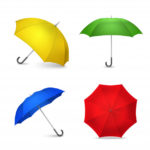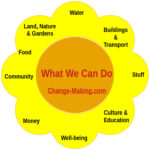
How do you sort out what’s really sustainable?
What is sustainability?” What lies on the path toward sustainability? What is a distraction? What takes us in the opposite direction? I’m using the word discernment to describe the process of figuring that out.
Discernment isn’t a term that you hear very often. But then again, making an independent judgment based on a particular objective isn’t necessarily a popular thing to do. Mainstream capitalism, controlled by The Man (the extreme wealthy — think Forbes 400 — together with their intertwined multinational corporations), wants to make those decisions for you, and market to you want he wants you to buy. However, if we’re going to solve the problems of the world, we’ve got to get good at making decisions, making a judgment whether a proposed solution really will work or not.
Discernment basically means figuring things out — usually figuring things out from a specific point of view. In contemporary terms, it’s viewing your options through a particular lens. And our lens, our filter, is solving the massive problems we’ve been talking about in this course.
Discernment
the quality of being able to grasp and comprehend what is obscure : skill in discerning
Obscure
— Merriam-Webster
1a: dark, dim
b: shrouded in or hidden by darkness
c: not clearly seen or easily distinguished
The definition of discernment relies on the word obscure, which can mean dark or dim. You could certainly say that we’re trying to comprehend the dark underbelly of this supposedly successful and prosperous Western Civilization. These issues are not talked about in mainstream society, so you could say that they are dim.
The second definition — shrouded in or hidden by darkness. We’re told to pay no attention to those efforts to mislead the public, for example the campaigns to cast doubt on climate science. It gets even more intense when we talk about more, more, more. The Occupy movement questioned The Economy, so Occupy was squelched, quieted. The Movement for Black Lives calls attention to racial disenfranchisement, and The Man funds political efforts to worsen it. Big corporations and The Economy and The Man are doing everything they can to bury biocapacity issues.
But let’s look at that third definition: the answers are certainly not clearly seen or easily distinguished. They are certainly muddied. Most people don’t have the ability to sort it out. But you do.
Does the action create more life or reduce it?
— Paul Hawken (Olaniyan, 2021)
Does it heal the future or steal the future?
Does it enhance human well-being or diminish it?
Does it prevent disease or profit from it?
Does it create livelihoods or eliminate them?
Does it restore land or degrade it?
Does it increase global warming or decrease it?
Does it serve human needs or manufacture human wants?
Does it reduce poverty or expand it?
Does it promote fundamental human rights or deny them?
Does it provide workers with dignity or demean them?
In short, is the activity extractive or regenerative?
When someone proposes a solution, we need to evaluate it. And as we evaluate, it’s a sorting process. We go through the pile of proposed solutions and we say, “This one won’t work. It’s junk.” That one, “meh, it doesn’t quite get the job done.” But this one over here, yay, it’s a true solution!
As we’re sorting, we’re tossing the junk ideas into the landfill. These yucky ideas are going on a linear journey — “do not pass go, do not collect $200” — straight to the landfill.
Some ideas will be “meh.” They’re close, but not fully developed. These ideas we could toss into a compost bucket, to digest further — perhaps breakdown and reform into something useful. Perhaps at some future point they will have evolved into something worthwhile.
But ultimately we’re hunting for a true solutions, those solutions which pass all the tests. These are the ones which we want to celebrate, we want to tell all our friends. These are the ones we want to focus on, to bring alive.
Another world is not only possible, she is on her way. On a quiet day, I can hear her breathing.
–Arundati Roy
Good solution or poor solution?
How do you make the call whether something is a good solution or a poor solution?
Think of it like when you’re cooking pasta in your kitchen. The pasta and the water are all mixed up together, bubbling along on the stove. When the pasta is done you dump it into a strainer. The strainer saves the good stuff, the pasta, and the water flows through the sieve. We need a sorting mechanism like that.
But our sorting mechanism actually has two layers. So we’re going to use both a sieve and a colander. Say, for our little example, you were cooking pasta, and your roommate came along and dumped quinoa in the same boiling water. More efficient right? Not really, because somehow you have to sort it all out. What are you after? Ultimately, you’d like a bowl of pasta. Ultimately, we’d like a bowl of true solutions.
So we take all the proposed solutions — this mixed up pile of so-called “solutions” includes some true solutions, but it also includes half-baked solutions which need more work, it includes Business As Usual disguised as greenish. This is like our pasta, quinoa and water all mixed up.
We take all these proposed solutions, and we dump them through our sieve, our question: Do these proposed solutions address the problems of The Great Unraveling?
What happens when we dump our mixture into the sieve? What do we capture? We capture the quinoa and the pasta. So we’ve captured our true solutions, but we’ve also captured temporary solutions, band-aid ideas, and greenish ideas.
But at least this sieve — our first question — means the Business As Usual garbage flows away. We’ve removed more-more-more ideas, we’ve removed greenwashing, we’ve removed things that we know are no way going to take us towards sustainability.
But we need greater clarity. We need to sort out that stuff caught in our sieve.
So let’s take our crazy mixed up pasta + quinoa over to the colander. When we dump the contents of our sieve into the colander, we’re putting it through a different question. Does it address our system of ethics? Does it address Holmgren’s Ethics: earth care, people care, and fair shares? You may have additional ethical systems you apply, such as indigenous wisdom.
Now what rinses through the colander? The quinoa. These are ideas that need further cooking, further work. They might be temporary, short-term solutions. They might be greenish ideas.
What we capture in our colander? our pasta. Our true solutions. A few temporary solutions might stick around, but for the most part we’ve isolated our true solutions. These true solutions have been through both filters. They address the problems of The Great Unraveling, and they address the Holmgren system of ethics. These are the kind of ideas we want to get up and running as soon as we can. We want to bring these to life.
What I’ve found is that there’s a certain type of solutions that make it all the way through both filters. These are going to be ideas which address climate, biocapacity, economic dysfunction, and disenfranchisement at the same time. They help heal them all. They’re powerdown solutions, probably localized solutions. And they don’t look very much like the comodify-everything, buy-everything, sparkly, glossy, shiny lives many of us live today. Some people may say this pool is quite limited. I would counter that by saying this pool is remarkably cohesive — the solutions are all interrelated.
It doesn’t matter where the solutions come from. They don’t need to have some sort of stamp of approval like “certified organic,” “LEED,” or “permaculture approved.” In fact, it’s best to open our mind to true diversity, to recognize that people all over the world are creating solutions that will make it through these filters.
What does this look like in practice?
When you get a new book or hear of a new “solution,” you need to ask yourself: Does the person who thought up this thing understand The Great Unraveling? Does this person know about climate change + peak everything and biocapacity + the problems baked into The Economy + disenfranchisement? Were they holding the big umbrella problems in mind as they dreamed up their proposed solution?
If the author doesn’t make it clear that they understand this set of problems — or, worse yet, you can see that they’ve overlooked one of the big umbrella problems — ditch the book, it likely won’t be very good. A book about “green” business that ignores the problems of infinite growth and economic disenfranchisement? Useless. A book about climate “solutions” that ignores biocapacity? Very limited in its usefulness.
But say it passes Test #1. Now we take our book — our proposed solution — to the second question. We take a look at what the author came up with.
Does the proposal truly help? Does this proposal that this author designed really support and further The Great Turning? Does it move us further down the road toward sustainability, or does it leave us treading water, pretty much we are? Does it help restore balance between earthcare, futurecare, and the concerns of people here today? Does it value earthcare — the preservation, restoration, and regeneration, and integration of natural ecosystems? Does the proposed solution restore the concept of fair shares? As it takes care of people, does it take care of all people, undoing disenfranchisement, restoring balance within the populace?
If you get a “yes” to many of those, you’re on the right track. If you get a “yes” to all of those, you’ve likely found a true solution.
Reflection – Discernment
Think of a proposed solution, something you’ve been told is “greener.” Try running it through the sieve-and-colander system.
- Does the proposed solution address the problems of The Great Unraveling?
- Does it address Holmgren’s Ethics: earth care, people care, and fair shares/futurecare?
Is this proposal a true solution?
Have you seen my mini-course, “Greener or Greenwashing?“



